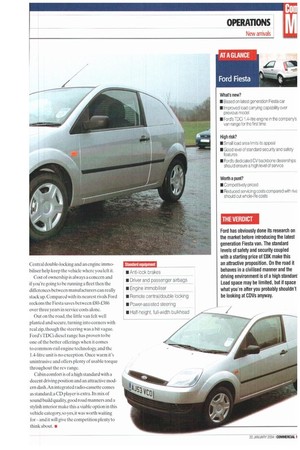FIESTA GEARS UP
Page 54

Page 55

If you've noticed an error in this article please click here to report it so we can fix it.
ft's been two years in the pipeline but Ford's all-new Fiesta van is finally here. Julian
MiInes reckons it was worth waiting for.
airhe launch of a commercial vehicle by Ford is always a major event,such is its dominance of the light CV market. There may be manufacturers that eclipse the company in specific vehicle categories, but the blue oval's products will always be seen as the ones to heat.
Ford has been without a replacement for the previous fiesta van since January 2002, when the last example of the old model rolled off the production line. Since then the Peugeot 206 and Vauxhall Corsa vans have surged ahead in this category, taking market shares of 3213/0 and 25% respectively (in 1999 Ford held 65% of the market).
Ford is aggressively marketing the Fiesta van in its bid to regain its dominant position —the company aims to sell more than 4,000 Fiesta vans a year in a sector that accounted for 6,285 vehicles in 2002, Its target market is couriers and tradesmen, though major fleet operators and the rental fleets are expected to make up two-thirds of sales.
Based on the Fiesta passenger car, the new van comes with a choice of two engines: a 1.4-litre TDCi diesel (the first time the unit jointly developed by PSA/Ford has been used in the company's van range) producing 67hp/160Nm: and a Duratec 1.3-litre petrol engine with 69hp/106Nm on tap. Ford claims the TDCi version offers fuel consumption of 65.7mpg:it's expected to account for 95% of sales.The price has been kept competitive, with the petrol version starting at £8000 (exVAT') and the diesel at £8,350 (ex-VAT).A factory LPG option will not be available, but a number of independent companies will be able to supply conversions.
Length does matter Payload is set at 494kg and the VDA-rated load capacity is 1.01m3, with load length a bestin-class 1,320mm.The load area is secured by a half-height solid bulkhead as standard with an optional steel mesh upper.
Ford is keen to highlight the advances it's made in the level of standard equipment ma bid to give the Fiesta a competitive edge. On the safety side you get dual-stage driver and passenger airbags,ABS with electronic brake force distribution, anti-submarining seats, collapsible steering column and a body structure that is 40% stronger than the previous model's. Central double-locking and an engine immobiliser help keep the vehicle where you left it.
Cost of ownership is always a concern and if you're going to be running a fleet then the differences between manufacturers can really stack up. Compared with its nearest rivals Ford reckons the Fiesta saves between £80-1.386 over three years in service costs alone.
Out on the road, the little van felt well planted and secure, turning into corners with real zip, though the steering was a bit vague. l'ord'sTDCi diesel range has proven to be one of the better offerings when it comes to common-rail engine technology, and the 1.4-litre unit is no exception. Once warm it's unintrusive and offers plenty of usable torque throughout the rev range.
Cabin comfort is of a high standard with a decent driving position and an attractive modern dash. An integrated radio-cassette comes as standanka CD player is extra. Its mix of sound build quality,good road manners and a stylish interior make this a viable option in this vehicle category, so yes, it was worth waiting for — and it will give the competition plenty to think about. •




























































































































































































